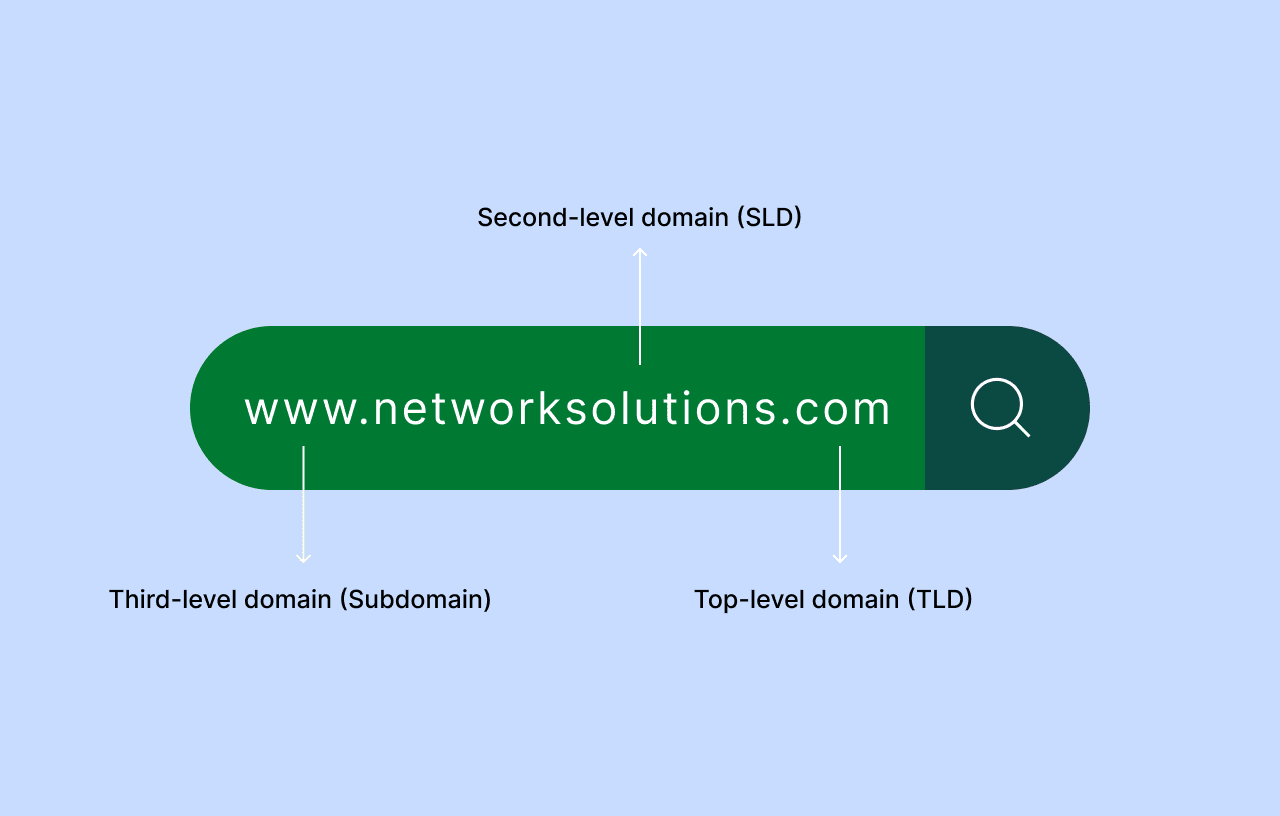Key takeaways:
- A second-level domain establishes a unique and memorable name for your website and brand. It helps people easily recognize and recall your business.
- Choosing a short and catchy second-level domain boosts your online presence by making it effortless for customers to find you through search engines.
- When picking your second-level domain, ensure that it’s relevant to your brand and is free of complex characters or numbers. This guarantees that your domain will remain memorable.
What makes a business website instantly grab visitors’ attention? A unique domain name. And what do you need to make a domain name stand out? A memorable second-level domain (SLD).
In this guide, we’ll explain what an SLD is and its role in the domain name structure. We’ll also cover why it’s important for your business and include tips to help you choose the right one.
What is a second-level domain (SLD)?
A second-level domain is the part of a domain name located right before the top-level domain (TLD). It typically indicates the company or brand that owns the website. It can also describe the kind of content, activity, or purpose of a site. All of which makes an internet address unique.
For example, in “www.networksolutions.com,” “networksolutions” is the SLD.
A well-chosen SLD can:
- Make a site more memorable
- Help search engine optimization (SEO) efforts
- Strengthen brand reputation
Real-world second-level domain examples
Let’s look at some familiar examples:
- google.com
- facebook.com
- feedingamerica.org
Here’s a breakdown of how each SLD helped businesses and organizations succeed online:
Google.com
The SLD “google” is short, memorable, and unique. It helped Google become a household name and even a verb, which shows how a strong brand identity tied to a distinct SLD can drive massive online success.
Facebook.com
Similar to Google, “facebook” is concise and instantly recognizable. It quickly tells users what the website is about. A straightforward SLD like this is important for a social platform aiming for widespread adoption and frequent visits.
Feedingamerica.org
“Feedingamerica” clearly communicates the organization’s mission. With a well-thought-out SLD like this, non-profit organizations establish credibility and attract the right audience who genuinely cares about their work.
Contrary to the examples above, some countries consider an SLD as part of the domain extension, which is called a country-code second-level domain (ccSLD).
The ccSLD often identifies the organization type or purpose of the website. It sits between the chosen name and the country-code TLD (ccTLD).
For instance, in “www.example.co.uk,” “co.uk” is the ccSLD. It tells you that the site is for a commercial entity in the UK.
Here are more examples from other countries:
| ccSLD | Purpose |
|---|---|
| edu.au | For educational institutions in Australia |
| net.in | For network providers in India |
| gob.mx | For government agencies in Mexico |
How are the top-level domain and third-level domain different from the SLD?
The three levels of a domain name have different purposes, and all are equally important for a complete web address. Since we’ve already covered the SLD, let’s go into more detail about the TLD and the third-level domain (subdomain).

Top-level domain (TLD)
The TLD is the part that comes after the SLD. It’s the last section of a web address that tells you the nature of a website.
For instance, .gov is often used for government entities while .edu is reserved for educational institutions.
The most popular ones are the generic top-level domains (gTLDs) .com, .org, or .net.
Even though TLDs don’t have the same branding power as SLDs, they still matter, as they help categorize your site for visitors and search engines. Not having a specific TLD potentially leads to losing out on many new users.
Third-level domain (Subdomain)
A subdomain comes before the SLD. For example, in “blog.example.com,” “blog” is the subdomain.
Subdomains are useful for organizing your website’s content or creating specific areas for different services. You can separate your site into:
- An online store
- A blog
- A support section
Subdomains let you expand your site’s functionality while keeping everything under the same brand name.
Why are second-level domains important for your brand?
An SLD offers various benefits and functions for your website and brand. These include:
- SEO benefits
- Brand recognition
- Reliability
- Consistency
- Memorability
It’s important to understand how an SLD adds value to your online presence so you can use it more efficiently. Let’s go over each advantage and purpose:
SEO benefits
While the SLD isn’t the only ranking factor in search engines, it can still impact your site’s visibility. A memorable SLD that includes keywords relevant to your business can increase your chances of appearing higher in search results.
This is important for improving your site’s click-through rates (CTR) and helping potential customers find you more easily.
However, keep in mind that modern SEO favors memorable domains over keyword stuffing, so balance is key.
Brand recognition
Your SLD is the part of your domain that people remember. It’s your website’s “face” online. A strong, relevant SLD reinforces your brand identity, which helps customers easily recognize and engage with your site.
Reliability
On the internet, reputation is everything. Your SLD can either add to or take away from that reputation.
A professional and recognizable SLD lets your visitors know that your site is trustworthy and legitimate. Earn your customers’ trust with a well-thought-out SLD. Don’t choose an overly complicated one, as it raises doubts about your site’s authenticity.
Consistency
You can use your SLD across various platforms, such as:
- Social media
- Marketing materials
You can efficiently tie all your online assets together with a consistent SLD. Plus, customers will have an easier time finding you, with the same brand SLDs.
Memorability
A good SLD is easy to remember and share, making it more likely that visitors will return. Having a simple and catchy domain name encourages word-of-mouth promotion of your site. This helps drive traffic and keeps people coming back to your website.
How to choose the right second-level domain
Selecting the right SLD requires careful planning. Consider these tips to make sure you land on the perfect SLD for your brand:
- Keep it short and simple
- Make it brand relevant
- Avoid numbers and special characters
- Check availability
- Consider future growth
Let’s look closer at these suggestions to help you pick the right SLD:
Keep it short and simple
Aim for something easy to spell, pronounce, and remember. Shorter domains are generally more user-friendly and recognizable.
Make it brand relevant
Your SLD should reflect your business or personal brand. Think about how you want your customers to recognize you and ensure your domain aligns with that identity.
Avoid numbers and special characters
Adding numbers and special characters to your SLD can make it harder to remember and type. Stick with straightforward words that represent your brand.
Strong SLD examples:
- www.globaltech.net
- www.greenharvest.org
- www.womenglow.com
Weak SLD examples:
- www.protools247.tech
- www.eco-friendly-living.com
- www.88deals.info
Check availability
Make sure the SLD you want is available. Most domain registrars offer free domain name search tools to see if your preferred choice isn’t taken yet.
If you need more ideas, you can also use an AI Domain Generator to help you come up with available SLDs easily. To use the tool, you’ll typically need to refine your results by setting the:
- Domain name length
- Words that should be included
- Domain extension
Consider future growth
If you plan to expand your business, choose an SLD that can grow with you. Avoid domains that are too specific or limiting.
Make your mark with an impactful second-level domain
Second-level domains are often overlooked when building a website. However, understanding their value is necessary to establish your brand online successfully.
Your SLD serves many functions, such as being:
- The foundation of your brand
- The first impression visitors get
- A key factor in how people find and engage with your site
Be among the best websites online and claim your SLD with Network Solutions. Read our article about how to register a domain name to get you started.

Frequently asked questions
SLDs can impact your SEO indirectly by making your website easier to find and more relevant to specific keywords. While the SLD isn’t a direct ranking factor, a memorable domain with related keywords can improve traffic rates and search visibility.
An SLD is the unique name you choose for your web address and is found right before the TLD (e.g., “.com” or “.org”). For instance, in “solesisters.com,” “solesisters” is the SLD.
Meanwhile, a subdomain is an addition you make to your existing SLD and is located right before it. It’s used to organize content or make separate sections of your site. For example, in “shop.dogcare.com,” “shop” is the subdomain.
You register SLDs, but you create subdomains yourself under that registered name.
ccSLDs are domains specific to a country and are found before the TLD. To provide an example, in “falgships.co.uk,” “.co” is a ccSLD under the “.uk” ccTLD. Organizations or businesses within a specific country often use these domains.
Yes, any website can register an SLD if the name you want is available. An SLD is necessary when registering your actual domain name, as it differentiates your site from others.
While you can’t change an existing SLD once it’s registered, you can always register a new one.
However, be aware that changing your domain can impact your:
SEO
Existing backlinks
User familiarity
If you do decide to change it, ensure to redirect traffic from your old domain to your new one properly.




